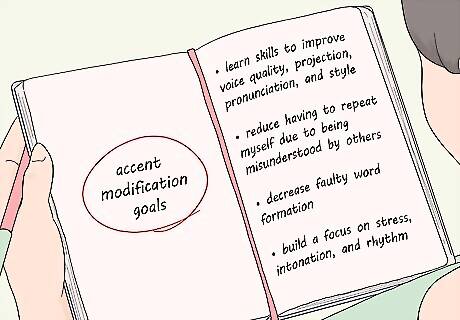
views
Practicing on Your Own

Develop a large vocabulary. Start by reading glossaries of southern "colloquialisms," or vocabulary. Learning more about your own speaking habits will help you to recognize when you’re slipping into a a more "southern" speech pattern. Then, use vocabulary-building books to find more neutral alternatives to replace these local colloquialisms.. Start a vocabulary journal to help you learn and remember the new words. Focusing on the new words will force you out of your accent comfort zone, and will go even further to help you present a more educated and professional image For example, minimize the use of "ain't" and "y'all, replacing them with "am not" and "you" or "you all," respectively. Additionally, say "preparing to" instead of "fixin’ to."

Work on your grammar and sentence structure. Some grammatical constructions not only seem quaintly southern, they’re also incorrect or confusing to non-southerners. Use concise and concrete language to provide directions or descriptions. For example, don’t use an extra pronouns in instructions: "Go get you a stapler from the supply room,” emphasizes a regional dialect, while “Go get a stapler from the supply room" is straightforward and correct. Avoid double-prepositions like stating that an object is "Up under" something. Instead, just use the preposition “under.”

Pronounce your vowels and consonants more clearly and quickly. Southerners tend to speak more slowly than Northerners, so picking up your pace a bit can offset the impression of a drawling speech style. "Clip" or shorten your vowels. The vowel “i” often gets drawn out in southern speech styles, which is called "glide deletion," so when saying the pronoun “I,” for instance, pronounce with the sharper “ai” rather than the softer “ah.” You can try to speak with your mouth in more of a circular shape to achieve the effect of rounding out your vowels instead of flattening them. Try it with the word “wine,” so that you’re saying “waiyn” and not “waihn” Place the accent on the second syllable of words such as cement and umbrella. For example, the word “cement” should be pronounced “suh-MENT” and not “SEE-ment”

Pronounce the consonants and vowels in the middle of words. Leaving out letters sounds less professional, and also indicates a regional accent, and so gives a less polished impression. For instance, pronounce the “r” in “library,” to avoid saying “liberry.” Other examples are the “y” in “crayon” and the second “a” in “caramel;” Without those letters, they sound like “crown” and “carmel.” Include the final /ng/ sound at the ends of verbs and gerunds, such as “walking,” so that you say “Are you walking to the park?” instead of “Are you walkin’ to the park?” Be sure to include both words in short phrases like “going to” and “want to,” and avoid saying “gonna” and “wanna.”

Read a book about accent modification. Some are specifically designed to help you reduce your southern accent, such as Say Goodbye to Your Southern Accent, a book and CD set. These texts provide information and practice exercises to help you to change your speech patterns through exposure to neutral dialects and repetition exercises.

Practice imitating your new accent in private. You may feel nervous about practicing in public at first, so try a repetition method that will allow you to become more comfortable. Try listening to national radio new broadcasts and repeating the sentences back while you drive to work or run errands, or while working around the house. Consider recording yourself repeating the words or reading some text. You can then listen to yourself and make notes about problem areas. You can then try the whole process again until you feel confident that you’ve modified your southern accent to a more neutral one. Watch yourself in a mirror so that you can monitor your mouth shape as you speak.

Practice your new accent with a friend. Find a friend with a more neutral American accent and ask him or her for help. Plan to meet them in a comfortable place where you can talk about a variety of topics, like a coffee shop or on a shopping trip, and explain your plan to practice speaking with less of an accent. Decide, with your friend, how you will practice. You might ask your friend if he or she notices any words that seem particularly accented, and you can practice repeating those words back to your friend in a more neutral accent. You might also simply have a conversation, as usual, with your friend will occasionally stopping you to point out accented speech or southern colloquialisms. You can then discuss and try new ways of saying the same things.

Practice using your new accent with strangers. Trying out your new standard American dialect on strangers might feel awkward to you, but it’s a powerful way to practice in real-life situations. Try speaking to baristas in coffee shops, servers in restaurants, store clerks, and flight attendants, since you may not see these particular service personnel again and you can avoid later embarrassment if you feel uncomfortable.
Listening to Your Preferred Accent

Take an online dialect quiz. These quizzes are not only interesting, they can show you a number of regionally-specific terms for everyday objects or activities. Knowing these highly specific terms will help you to avoid them, and, thus, avoid sounding particularly "southern." The New York Times dialect survey is a popular quiz and uses mostly vocabulary to place your dialect. If you’re looking for a wider variety of accents, there are a number of surveys and quizzes on worldwide accents, as well as varieties of English.

Listen to radio stations and news programs that use a more neutral American accent. While music DJs on the radio are trained speakers, they often use the regional dialect associated with their audience. Instead, listen to programs that are broadcast nationally, as those hosts practice speaking in a more neutral, and conversational, dialect.

Watch informational television shows. National news stations, like CNN, MSNBC, FOXNews, have anchors and hosts who have had significant training in modification of their speech patterns. They speak clearly and with engaging enunciation, and are a good model of standard American English dialects. Watching the news anchors speak also provides you the opportunity to watch the way these trained speakers form the words with their mouths. Documentary television channels with voice overs, like the History Channel, NatGeo, and Animal Planet, are also good options, as the narrators are often trained actors.

Engage in conversations with friends or co-workers. The most powerful influence on your accent comes from your peers in everyday interactions, so the more you listen and respond, the more confident you’ll be in both knowing the sounds of a neutral American accent, and also speaking with one.

Ask a friend with a neutral accent to read aloud to you. If you’re going on a long drive, of if you have some down time, you might find it helpful to simply listen to someone read in a standard American accent. You can control the subject by choosing a text in your area of interest, and you’ll be exposed to higher-quality vocabulary, even in simpler books. Choose texts that relate to the area of your life that a modified accent will be of benefit, such as your career. Consider choosing a text about accent modification, so that you’ll have the double-exposure of a neutral accent and information on modifying your own.

Listen to an audiobook. Audio book narrators are often trained actors who know how to speak clearly and in standard American accents, as well as other dialects. Listening to them as they read a book can be both enjoyable and informative, especially if the text includes multiple dialects and accents. Several texts on accent modification are available as audiobooks, and include practice exercises to do while listening.
Training with Professionals

Determine if you need to seek professional training. If your co-workers or friends are having difficulties understanding you, even if you’ve been practicing on your own, it might be time to seek out a professional speech-language pathologist (SLP) for help. SLPs work with clients on speaking rate, rhythm, intonation, public speaking, conversation, and accented sounds. Many larger universities have high-quality speech-language pathology clinics, so check your local university first. Use the search tools at non-profit organizations for speech-language pathology to find a certified SLP.

Research professional accent or dialect modification options in your area. A basic Internet search for "accent reduction," "accent modification," or “dialect modification” and the name of your locality. Some resources offer individual training, while others have group lessons. Group classes might be useful if you want to practice your accent with a wider variety of people. Individual sessions are an option if you want to build more confidence before you practice with others, or if you need a more flexible training schedule.

Contact your chosen professional or speech-language organization. Some clinics and professionals will request a phone consultation to evaluate your needs and goals before beginning your training.

Go to your first appointment. In order to help you meet your particular goals, your SLP will first evaluate your speech patterns. He or she will ask you to read texts and words of various lengths, as well as engage you in a conversation. He or she will be listening to your pronunciation, intonation, rhythm, and syllable stresses.The SLP will also listen to your speech in conversation.

Set your accent modification goals. With your SLP, determine your goals for your accent modification process. These goals should be based on your personal and professional needs, as well as the evaluation of your southern accent you completed. Some goals are highly career related, such as preparing for presentations, performances, or interviews. Be as specific as possible when having this conversation with your SLP. Your later sessions, in some cases, will be aimed at achieving these specific goals, so be clear about them early. You can also adjust them along the way, as your skills and needs change.

Keep practicing, even after your program or training ends. The sounds of your first language, including regional dialects, were imprinted by the time you were a year old, so you’ll always have the hint of your original accent in your voice. Continued practice with your new, neutral dialect will reduce the effect of your accent over time.

















Comments
0 comment